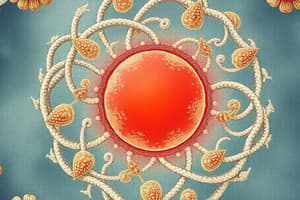Podcast
Questions and Answers
Which of the following is NOT a type of membranous organelle?
Which of the following is NOT a type of membranous organelle?
- Golgi complex
- Lysosomes
- Mitochondria
- Nucleus (correct)
Intrinsic proteins are also known as peripheral proteins.
Intrinsic proteins are also known as peripheral proteins.
False (B)
What is the function of the glycocalyx?
What is the function of the glycocalyx?
It plays a role in immunological specificity and acts as a protective mechanical barrier.
What type of transport requires energy?
What type of transport requires energy?
What structures increase the absorptive surface area in epithelial tissue?
What structures increase the absorptive surface area in epithelial tissue?
The cell membrane is primarily composed of lipids, proteins, and __________.
The cell membrane is primarily composed of lipids, proteins, and __________.
What are the two main classes of proteins in the cell membrane?
What are the two main classes of proteins in the cell membrane?
Match the following descriptions with their components:
Match the following descriptions with their components:
Study Notes
Membranous Organelles
- Permanent structures found in nucleated cells
- Contain enzymes and are enclosed in membranes
- Involved in cellular metabolism
- Examples include the cell membrane, mitochondria, Golgi complex, lysosomes, peroxisomes, endoplasmic reticulum (rough and smooth), and coated vesicles
Cell Membrane Proteins
- Extrinsic or peripheral proteins are loosely attached to the cell membrane's surface and can be easily removed
- Intrinsic or Integral proteins are firmly embedded in the lipid bilayer
- Transmembrane proteins extend across the entire width of the plasma membrane (lipid bilayer)
- Some transmembrane proteins are "one-pass" or "multipass" proteins, and are involved in transporting molecules in and out of the cell
The Cell Coat (Glycocalyx)
- Layer of glycoprotein or glycolipid on the external surface of the cell membrane
- Plays a role in immunological specificity and contains blood group antigens
- Receptor sites are located here
- Cells are held together through this layer
- Forms part of the basement membrane for epithelial tissues
- Acts as a protective mechanical barrier
Cell Surface Specializations
- Lateral Surfaces:
- Junctional complexes and interdigitations are finger-like projections that interlock adjacent epithelial cells
- Basal Surfaces:
- Flagella are tails of sperm, helping their movement
The Cell Membrane (Plasmalemma)
- Ultrathin membrane (80-100 Angstrom) surrounding the cell
- Difficult to see in light microscopes (LM)
- Appears as two dark layers separated by a light one (trilaminar membrane) in electron microscopes (E/M)
- Made of lipids, proteins, and carbohydrates
The Lipid Component
- Composed of phospholipids, glycolipids, and cholesterol
- Phospholipids form a double layer
- Each phospholipid molecule has a polar (hydrophilic) head and a non-polar (hydrophobic) tail
- Polar ends are hydrophilic, charged, and directed outwards
- Non-polar ends are hydrophobic, non-charged, and directed inwards
Cell Membrane Functions
- Simple transport (diffusion): Gases and water can pass into the cell by a simple process of diffusion
- Active transport: Large molecules like sugar need energy to enter the cell
Studying That Suits You
Use AI to generate personalized quizzes and flashcards to suit your learning preferences.
Description
Explore the fascinating world of membranous organelles and cell membrane proteins in this quiz. Test your knowledge on structures like mitochondria, Golgi complex, and the different types of membrane proteins. Understand how these components contribute to cellular metabolism and immunity.




